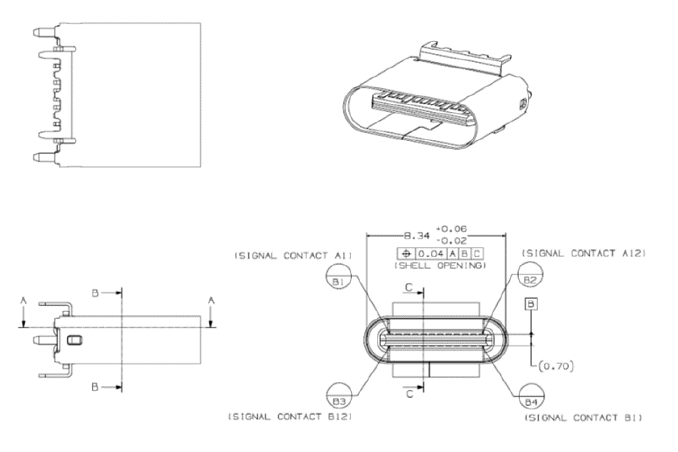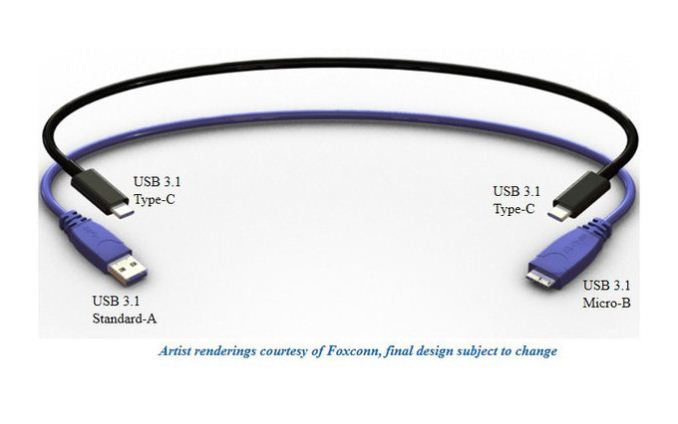USB Type-C Connector Specifications Finalized
by Brett Howse on August 12, 2014 11:50 PM EST
Today it was announced by the USB-IF (USB Implementers Forum) that the latest USB connector which we first caught a glimpse of in April has been finalized, and with this specification many of the issues with USB as a connector should be corrected. USB, or Universal Serial Bus, has been with us for a long time now, with the standard first being adopted in 1996. At the time, it seemed very fast at up to 12 Mbps, and the connector form factor was not an issue on the large desktop PCs of the day, but over the years, the specifications for USB have been updated several times, and the connectors have also been updated to fit new form factor devices.
In the early ‘90s, when USB was first being developed, the designers had no idea just how universal it would become. The first connectors, USB-A and USB-B, were not only massive in size, but the connection itself was only ever intended to provide power at a low draw of 100 mA. As USB evolved, those limitations were some of the first to go.
First, the mini connectors were introduced, which, at approximately 3 mm x 7 mm, were significantly smaller than the original connector, but other than the smaller size they didn’t correct every issue with the initial connectors. For instance, they still had a connector which had to be oriented a certain way in order to be plugged in. As some people know, it can take several tries to get a USB cable to connect, and has resulted in more than a few jokes being made about it. The smaller size did allow USB to be used on a much different class of device than the original connector, with widespread adoption of the mini connectors on everything from digital cameras to Harmony remotes to PDAs of the day.
 USB Cables and Connectors - Image Source Viljo Viitanen
USB Cables and Connectors - Image Source Viljo Viitanen
In January 2007, the Micro-USB connector was announced by the USB-IF, and with this change, USB now had the opportunity to become ubiquitous on smartphones and other such devices. Not only was the connector smaller and thinner, but the maximum charging rate was increased to up to 1.8 A for pins 1 and 5. The connection is also rated for at least 10,000 connect-disconnect cycles, which is much higher than the original USB specification of 1,500 cycles, and 5,000 for the Mini specification. However once again, the Micro-USB connector did not solve every issue with USB as a connector. Again, the cable was not reversible, so the cable must be oriented in the proper direction prior to insertion, and with USB 3.0 being standardized in 2008, the Micro connector could not support USB 3.0 speeds, and therefore a USB 3.0 Micro-B connector was created. While just as thin as the standard connector, it adds an additional five pins beside the standard pins making it a very wide connection.
With that history behind us, we can take a look at the changes which were finalized for the latest connector type. There are a lot of changes coming, with some excellent enhancements:
- Completely new design but with backwards compatibility
- Similar to the size of USB 2.0 Micro-B (standard Smartphone charging cable)
- Slim enough for mobile devices, but robust enough for laptops and tablets
- Reversible plug orientation for ease of connection
- Scalable power charging with connectors being able to supply up to 5 A and cables supporting 3 A for up to 100 watts of power
- Designed for future USB performance requirements
- Certified for USB 3.1 data rates (10 Gbps)
- Receptacle opening: ~8.4 mm x ~2.6 mm
- Durability of 10,000 connect-disconnect cycles
- Improved EMI and RFI mitigation features
With this new design, existing devices won’t be able to mate using the new cables, so for that reason the USB-IF has defined passive cables which will allow older devices to connect to the new connector, or newer devices to connect to the older connectors for backwards compatibility. With the ubiquity of USB, this is clearly important.
There will be a lot of use cases for the new connector, which should only help cement USB as an ongoing standard. 10 Gbps transfer rates should help ensure that the transfer is not bottlenecked by USB, and with the high current draw being specified by connectors, USB may now replace the charging ports on many laptops as well as some tablets that use it now. The feature that will be most helpful to all users though is the reversible plug, which will finally do away with the somewhat annoying connection that has to be done today.
As this is a standard that is just now finalized, it will be some time before we see it in production devcies, but with the universal nature of USB, you can expect it to be very prevalent in upcoming technology in the near future.
Source: USB-IF












66 Comments
View All Comments
OreoCookie - Wednesday, August 13, 2014 - link
I don't get why they insisted on female plugs, wouldn't you get much smaller and sturdier connectors with something that resembles a Lightning plug?Morawka - Wednesday, August 13, 2014 - link
for backwards compatibility with Micro USB cablesOreoCookie - Wednesday, August 13, 2014 - link
Ugh. After having so many different mutually incompatible USB plugs (the above picture is missing at least one), why do they care?Samus - Wednesday, August 13, 2014 - link
Also cost. The lightning connector for the host and the cable are substantially more complex than this simple connector. Sure, they're sturdier, but they're bulkier and more expensive. USB needs to be incredibly cost effective in order to become a "Standard"hpglow - Wednesday, August 13, 2014 - link
I own two Apple devices with lightning connectors and I can attest that it isn't very durable. The official cords tend to last longest. But if even the slightest moisture hits the end it cooks the plating off the end. I know what people are saying... "so don't get it wet". Well for the most part that is no issue. But there is one charging station at the end of my couch and I have a 3 year old. For reference other cables have received worse abuse and continue to charge.Plus I'm sure there is some inane Apple patent on anything resembling a lightning connector.
Ethos Evoss - Thursday, September 25, 2014 - link
this a simple connector ? you stupid mental .. haha you know what? go study protocol of this and then come back . na�ve pathetic .repoman27 - Wednesday, August 13, 2014 - link
Type-C plugs and receptacles are not physically compatible with Micro-B plugs. You need to use an adapter. Also, the plugs are still "male" despite being a hole-in-a-post design. I'd reckon that's the sensible way to do it if you want to keep costs down, provide 360º shielding, and not have exposed contacts on a connector that can potentially provide up to 20 V, 5 A. The Type-C design also keeps the moving parts (spring contacts and retention latches) in the cable plug, which is generally easier / less costly to replace should they wear out / break.Ethos Evoss - Thursday, September 25, 2014 - link
doont worry there will be tons adapters ..Paul Tarnowski - Wednesday, August 13, 2014 - link
I haven't looked it up but it might be a patent thing. Which is stupid, but so are most patent things. Except the ones I'm going to apply for -- those are totally necessary.UpSpin - Wednesday, August 13, 2014 - link
In the USB case the connectors are protected. You can't short them by accident. They are also less likely to scratch, oxidate or get damaged, compared to the Apple lightning plug.I expected that those issues aren't important for the lightning plug because the bus works completely different. Each cable must have some sort intelligence (simple IC up to a full ARM SoC) which activates/deactivates the individual pins, to avoid a possible shorting and the likelihood of oxidation. This makes those cables very expensive!
http://www.chipworks.com/en/technical-competitive-...
In USB, the cables are simple passive cables and the voltage is always applied to the pins and you can damage your PC by shorting them. So you have to mechanically protect them.
However, on my search for the inside view of the simple charger cable I stumbled upon the Apple shop.
http://store.apple.com/us/product/MD818ZM/A/lightn...
Now I think, the lightning plug is a mechanical failure. I mean, a failure rate of almost 80% (probably 90% or more, because many people gave just one review but bought several cables already). A lifetime of several months, together with an exorbitant price for a charger cable.
Now I even find it funny that this didn't lead to a lawsuit yet.
And yes, Apple hasn't solved the issue with freely accessible supply pins either:
http://www.zdnet.com/lightning-cables-failing-due-...
It's a failure by design.
While the plug seems convenient and idea behind lightning superior, it suffers the same issues smartwatches like the LG G watch has with oxidation and the lightning tech. makes even simple charger cables expensive, even more video cables delivering mediocre, highly compessed, videos:
http://www.panic.com/blog/the-lightning-digital-av...